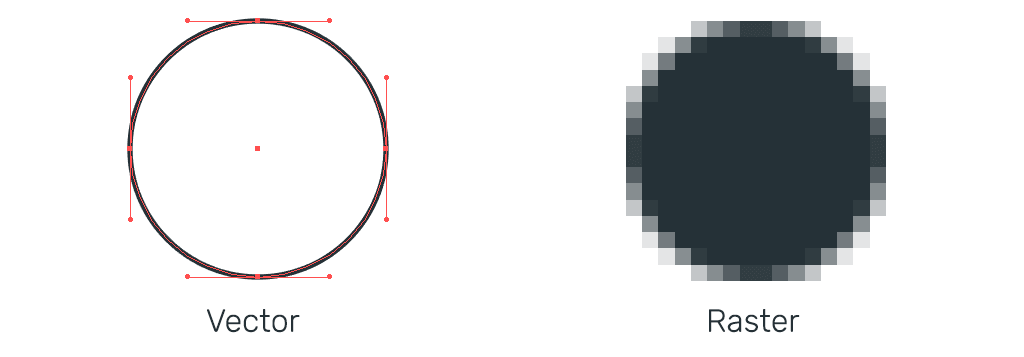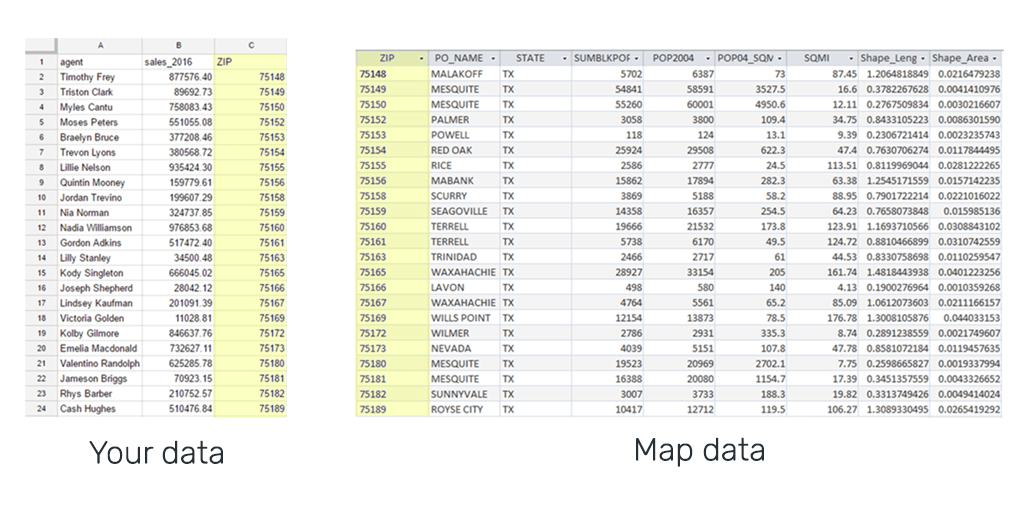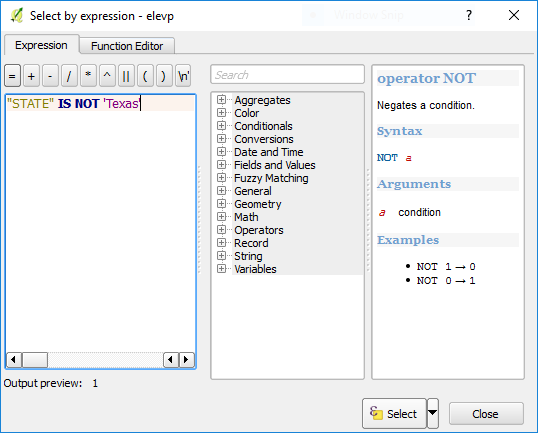How to Upload Own Files Into Gis for New Map
Now we understand what a GIS is and what is can practice, the next stride is to understand how a GIS is made. Just first you lot need to take a crash form in GIS information.
If you recall the term GIS is vague, so you oasis't seen anything yet. There are a dizzying array of formats used for storing GIS data.
Before we delve into the diverse formats permit's have a look at some fundamentals. Primarily there are two main types of GIS data: vector and raster.

Vector Information
You can remember of vector data as instructions for how to render data. The best mode to visualize it is to think of information technology equally a spreadsheet with columns that contain your regular data, but in add-on information technology always has an extra column called "geometry".
That column contains ane or more coordinates that depict how to draw the bespeak, line or polygon that represents that feature on the face of the earth.
Raster Data
If vector data is abstract, raster data is literal. Raster information is a bitmap image such as a TIFF or JPEG. This format is usually used for satellite imagery, aeriform photography, elevation models and topographic maps.
Introducing the Shapefile
The Shapefile is the most common format in GIS. It's a vector format that tin be read by almost all GIS systems.
The name Shapefile is a little deceptive because the file is made upwardly of at least four parts. The .SHP, the .DBF, the .PRJ and the .SHX.
It'south non of import that you call up what's in each function of of a Shapefile, simply I retrieve a brief explanation will help you lot amend understand how GIS data is structured in general.
SHP
This file contains the geometry of each feature.
DBF
This is a dBase file which contains the aspect data for all of the features in the dataset. The dBase file is very similar to a sheet in a spreadsheet and tin even be opened in Excel.
SHX
The .shx is the spatial index, it allows GIS systems to detect features within the .SHP file more apace.
PRJ
The .prj is the projection file. It contains data well-nigh the "projection" and "coordinate organization" the information uses.
Geometry Blazon
Every Shapefile tin only contain 1 geometry type. This ways that every feature in the dataset volition be either a bespeak, a line or a polygon. Yous can't have a dataset that contains a mixture of geometry types.
Almost beginner and intermediate level GIS users never demand to await any further than the Shapefile for storing and sharing map information.
So that wraps upwardly our introduction to the Shapefile.
Other Common GIS Data Formats
There a lots of other formats used in GIS. Each with their own distinctive benefits and drawbacks. Here's a quick list of other common formats that you might come beyond:
CSV - Comma Separated Value File
Although the CSV isn't exclusively a mapping format, it is often used in mapping. The beauty of the CSV is its simplicity. This simplicity ways they can exist read by almost any plan including the Excel or Google Docs.
It's literally a text file where columns are separated by commas and rows are separated by line breaks. When used in mapping, two extra columns are added to hold the x and y, or lat and lon.
For mapping purposes this format is only really used for sharing point layers. The downside of the CSV is that they are very easy to break. Only one comma in the wrong place and the file becomes unreadable.
File GeoDatabase
A file geodatabase is a collection of files in a binder on deejay that tin store, query, and manage both spatial and nonspatial data.
This is a popular format amid advanced GIS users. Just despite originally being touted every bit the favourite to replace the old simply entrenched Shapefile equally the defacto standard for sharing GIS data, the FileGDB never gained the pop support that many believed it would.
The main reason being its lack of support amidst open source GIS platforms.
Tab File
This format is very similar to the Shapefile and is the default format used by the MapInfo desktop GIS organization.
KML
This is the format most likely to be known by not-GIS users, as it is the default file format of Google Earth.
Unlike the other datasets covered hither, KML does more than simply store geometry and attribute information, it likewise contains lots of configuration options for Google Earth maps.
This actress information however makes KML less portable, as the additional information is only relevant to Google Earth and isn't of any value to other GIS systems.
GeoJSON
JSON or to requite information technology its total proper name JavaScript Object Notation is a lightweight data interchange format.
It'due south primarily used past software developers due to the ease with which it tin can processed by web applications.
GeoJSON is a course of JSON that too contains geometry data. Information technology'south not often used every bit a format for sharing spatial data for human consumption but is very pop as an output for API's (application programming interface).
GeoTIFF
The GeoTIFF is the near widely supported raster data format. TIFF is a bitmap prototype format similar to GIF, PNG or JPEG.
A GeoTIFF is just a regular TIFF that also contains special metadata that allows united states of america to know where it should be placed on a map.
A GeoTIFF is an uncompressed format. There are many other raster formats that offering compression to reduce the filesize, but these tend to exist proprietary formats that require additional paid software to use.
Sourcing GIS Information
Sometimes you volition exist lucky and have all of the data required for your maps up front. In other cases you will need to source and prepare information from a tertiary party source.
A mutual chore is taking data that contains location information such as an address or zip code and joining it with map ready information sourced from a 3rd political party.
For example you may have a spreadsheet that contains the number of sales made by county, in which case you will demand to source the canton map data and bring together it with your spreadsheet using a desktop GIS system, a procedure which we will look at in more detail subsequently.
The expert news is that virtually useful map data is freely available without restriction. The bad news is that there isn't a single authoritative source of map data.
Usually locating data merely requires a search engine and a lilliputian time and patience.
When looking for data information technology'south best to start with Google, the best approach is to search for the name of the dataset you desire followed by the word Shapefile, e.g. "Texas Counties Shapefile".

The map data will normally be provided as a zip containing the various files for the Shapefile.
Often the only style to actually see what a dataset contains is to download it and open it with a desktop GIS. We will be looking at the nearly pop desktop GIS systems later in the volume.
If you don't have any luck with Google so the next pace is to be more direct.
In North America and Europe most national and local regime websites will have a GIS department that contains GIS information bachelor for download. These sites are often not very user friendly and so finding and downloading things tin can exist a challenge.
Finally, if all else fails you can attempt contacting people who might accept access to the information and asking if you tin can utilise it.
For example if you wanted to map the forests of California and couldn't discover the relevant GIS data, y'all could try emailing the forestry section to run across if they tin share the data.
Near open up information available for download online is available for employ without restriction, but it's still polite to credit the source when using third party information or ask permission from the possessor of the data start.
Preparing GIS Data
Later on in the book I will be showing you the verbal steps for preparing map data using a desktop GIS. Just first I desire to innovate to you the general concepts.
Then let's just jump straight in and have a look at the well-nigh common data preparation tasks.
Table Joins
Here's the scenario. You take a spreadsheet that contains your data listed by nada code, and y'all would like to build a quantity map to visualize the distribution of the sales.
To do this you are going to need to discover null code map data and so join your spreadsheet to the map data so that information technology can exist used in a GIS.
And then kickoff you get and find the data by Googling "Shapefile Us zilch codes".

Once you have sourced the data you would open it in your desktop GIS and use the table join features to merge the datasets.
The table join works by choosing a column from the map data and the spreadsheet that contain shared unique values; e.one thousand. the zip code.
The GIS organisation will then find all records that match and join them together by appending the columns from your spreadsheet to the stop of the attributes for the map information.

Geocoding Addresses
Another common scenario is the need to map addresses.
The process of transforming an address into a coordinate is called geocoding and is offered past most desktop GIS systems.
It works past passing the address to a geocoding service that stores data almost the exact location of addresses for most developed nations globally.
The geocoder will then output a Shapefile that will contain your spreadsheet data in the form of attributes and a point on the map for each record in the new dataset.
Filtering a Dataset
Often map data sourced from third parties will contain features outside of your surface area of interest.
For example, you just want to map counties in Texas only the counties Shapefile provided past the Demography Bureau contains every county in the county.
The task here is to remove all of the features from the dataset that you aren't interested in.
In a GIS this is done by selecting features using an expression or query.
For example: "STATE" IS Non 'Texas'
In QGIS this expression would select all of the counties in the dataset which has a State aspect value other than Texas. Once selected, removing them is usually as elementary every bit hitting the delete key.

The above examples are just an introduction to the concepts. After in the book we volition be showing exactly how to perform these deportment using the a costless desktop GIS system chosen QGIS.
Read on for the fundamental cognition you'll demand to pick the right GIS solution for you.
Source: https://mangomap.com/gis-data
0 Response to "How to Upload Own Files Into Gis for New Map"
Post a Comment